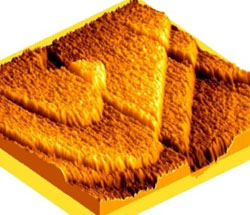STMs Make Mountains out of Molehills

Scanning tunneling microscopes (STMs) are among the most popular tools in modern science, but a group of theorists has some doubts about their accuracy. The group’s computer simulations, which are reported in the 3 December print issue of PRL, show that interactions between the STM tip and the surface can distort the instrument’s measurements. The results could lead to more accurate techniques and better algorithms for STM image processing.
STMs use a needle tipped with a single atom to take pictures of surfaces. Researchers apply a voltage to the probe, which induces a faint “tunneling” current from the surface into the tip. By recording changes in the current as they move the tip, scientists create a topographical image of an atomic surface.
In the two decades since their invention, STMs have been used to take snapshots of everything from rat cells to quantum dots, but theorists have yet to gain a thorough understanding of how they work. The problem, says Werner Hofer of University College in London, is that the interactions between the tip and the surface are difficult to model. “All the effects you could possibly imagine come into play,” Hofer says. “You have forces, fields, excitations–it’s a very complicated situation.” Several teams have modeled STMs, but the results have been contradictory and lacked the hard numbers experimentalists need to improve image processing.
To get results that experimentalists could use, Hofer–along with a collaboration of British and Canadian researchers–performed the most sophisticated computer simulation to date of the atoms in the tip and surface. By precisely modeling the outer electrons of the atoms involved, the team found that there is an attraction between the tip and surface. The attraction is so strong, according to Hofer, that it pulls atoms from the surface up to one atomic radius out of their normal positions. The change in distance alters the tunneling current and distorts the STM image–making a surface appear “rougher” than it actually is. Hofer believes that this distortion could explain why measurements of a gold sheet’s topography appear bumpier than theories predict.
“It might seem surprising that it’s taken two decades for STM measurements to become fully quantitative,” says Mark Freeman of the University of Alberta in Canada. “But the delay is a testament to the magnitude of the challenge.” Freeman calls the work a “tour-de-atomic-force,” which–along with a few other recent studies–will give researchers an exact understanding of their instruments.
–Geoff Brumfiel


